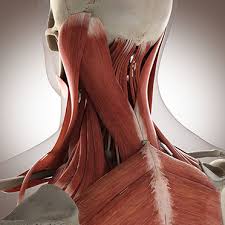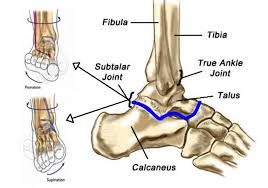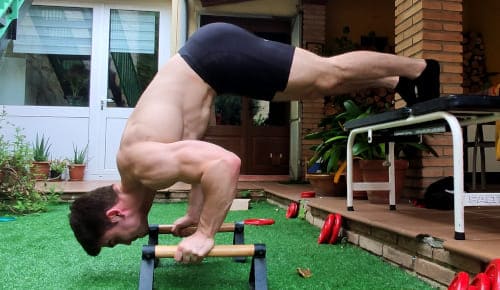9 Best Exercises For Stiff Neck
A stiff neck can be a persistent and discomforting issue, disrupting daily activities and diminishing overall well-being. Whether it’s caused by poor posture, stress, muscle strain, or other factors, finding effective relief is crucial for restoring comfort and mobility.
In this article, we’ll explore a range of exercises designed to target and alleviate the stiffness in your neck muscles.
These exercises not only promote flexibility and strength in the neck, but they also offer immediate alleviation and long-term health benefits. These time-tested exercises can help to Say goodbye to the tension and welcome a more pain-free, relaxed neck. They’re also simple to adopt into your regular routine.
Best Neck Exercises For Stiff Neck
Developing strong, flexible muscles and joints that can withstand tension and damage is the strongest defense against injury. the movement similar to the neck and back.
The risk of back or neck discomfort increases when one spends extended amounts of time in a static posture, such as hours spent in front of a computer screen. Movement is the best preventive treatment for back and neck discomfort. Take regular breaks to stretch away from the computer screen.
These basic neck pain exercises are designed to help treat mild episodes of neck pain. Some are even useful for relieving neck pain while working.
Neck Glide
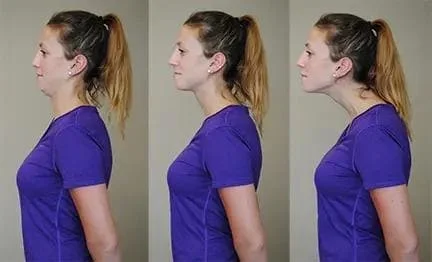
A neck glide is a mild stretching exercise that can assist in increasing the neck’s flexibility and range of motion. Moreover, it can aid in the relief of stiffness and pain.
However, Stretching your neck muscles safely and effectively is possible with neck slides. You can perform them every day to help increase your flexibility and range of motion.
Steps To Follow:
- Sit or stand up straight, with your shoulders relaxed, to perform a neck glide.
- Lower your chin into your chest as you slowly tilt your head forward.
- Then slowly raise your head so you can see the surface of the ceiling.
- Hold for a few seconds again. Repeat the movement 5-10 times.
- Note: If you feel any pain during the exercise, stop immediately and consult with your doctor.
Neck Extension

Exercises for neck extension aim to strengthen the muscles at the back of your neck, which may help with pain relief and posture. To prevent damage, it’s necessary to begin slowly and slowly push the intensity of your activities.
Your workouts can be made more intense as you advance by upping the resistance, holding the exercises longer, or adding more repetitions. But it’s crucial to pay attention to your body and quit if you start to feel pain.
Steps To Follow:
- Lying on your stomach
- Extend your arms above your head.
- Maintaining a neutral neck posture, slowly raise your head and chest off the ground.
- After holding for a short while, gently lower again.
- Repeat 10-15 times.
Neck Rotation
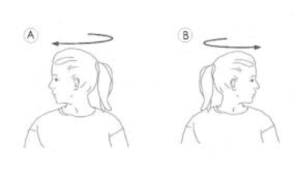
Move your head slowly and softly back and forth. Keep your head small and avoid turning it entirely to either side. Keep your chin parallel to the floor and avoid lowering it to your chest.
This is a beneficial exercise to perform while at work, particularly if your job requires you to maintain a constant head posture for long stretches of time, like when using a computer. To avoid neck discomfort, perform this exercise every 30 minutes.
Steps To Follow:
- Start by focusing directly ahead.
- Turn your head to the left slowly.
- Return to the starting position after holding for ten seconds.
- Turn your head to the opposite side slowly after that.
- For ten seconds, hold.
- Go back to where you were before.
- Then Repeat It 10 Times.
Lateral Extension
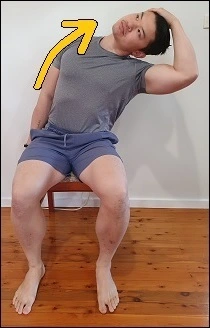
A mild stretching exercise that can assist in increasing the range of motion and flexibility in the neck muscles is called lateral neck flexion, or lateral neck bending. Moreover, it can aid in the relief of stiffness and pain.
Steps To Follow:
- Keeping your shoulders relaxed, sit or stand erect.
- Hold your chin up straight and keep your face neutral.
- As you progressively tilt your head to one side, place your ear close to your shoulder.
- Without putting your head in an uncomfortable posture, maintain a mild stretch.
- As you tilt your head more, place your hand on the other side and gradually provide resistance.
- This can aid in lengthening the stretch and focusing on the neck’s deeper muscles.
- Breathe steadily while maintaining the lateral flexion position for five to ten seconds.
- Return your head to the starting neutral position slowly.
- Repeat the exercise on the opposite side, tilting your head to the other shoulder.
- Perform 5-10 repetitions on each side, gradually increasing the number as your flexibility improves.
Shoulder Shrugs
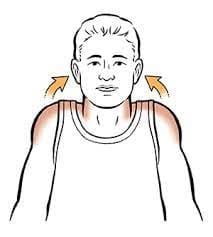
Shoulder shrugs are an easy-to-do but powerful exercise that helps build stronger upper back and shoulder muscles. They are also excellent for promoting better posture and relieving stress.
Steps To Follow:
- Place your arms at your sides and your feet shoulder-width apart as you stand.
- As though trying to touch your ears with your shoulders, slowly lift your shoulders up towards them.
- After a few moments of holding, gradually drop your shoulders once more.
- Repeat 10 to 15 fifteen times.
Tilted Forward Flexion

Bending the head and neck forward from a neutral position is called tilted forward flexion. People with bad posture and those who spend a lot of time on their laptops or cell phones frequently exhibit this movement.
An easy exercise to help stretch the muscles at the front of your neck and increase your range of motion is the Tilted Forward Flexion. It is also an effective workout for reducing stiffness and soreness in the neck.
Steps To Follow:
- Maintain a straight back and relaxed shoulders whether you stand or sit.
- When you feel a stretch in the front of your neck, slowly lower your chin towards your chest.
- For five to ten seconds, hold the stretch.
- Return to the starting position slowly.
- 10 to 15 times, repeat.
Deep Stretching
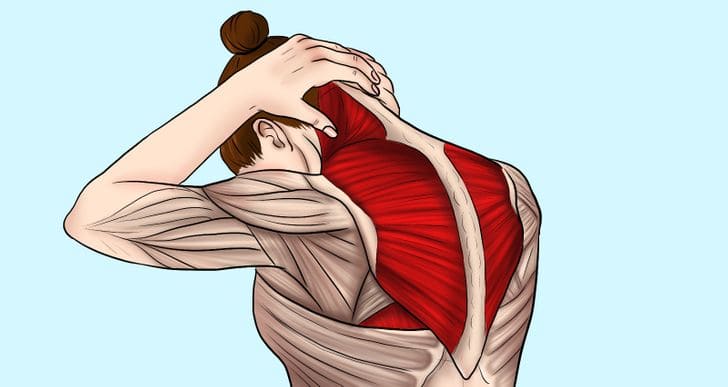
Here are some deep stretching exercises for your neck:
Steps To Follow:
- Maintaining proper posture, tilt your head to rest against your shoulder.
- You can use your hand as demonstrated to apply pressure.
- You might even use the other hand to grip your chair.
- 3 times, hold for 30 seconds.
Resistance Presses
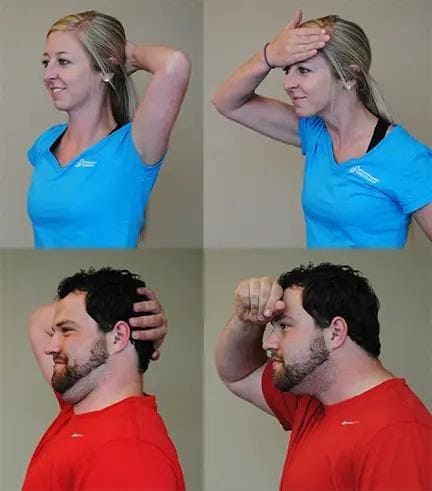
One kind of isometric neck exercise that can help build stronger neck muscles is resistance pressing. They may also be useful in easing stiffness and pain in the neck.
Steps To Follow:
- At all times, maintain a neutral head position.
- In the following positions, press into your head for five seconds, then release the pressure.
- Stretch: raise a hand to the forehead.
- Extend: place your hand behind your head.
- Do this for 30 seconds.
Towel Pull
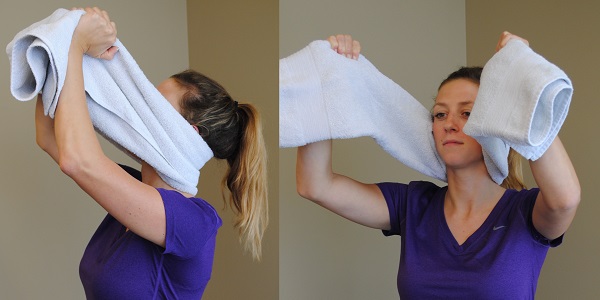
A towel pull is a type of cervical traction that can be used to relieve neck pain and stiffness. It’s an easy-to-do, at-home workout that works wonders.
Steps To Follow:
- Using your hands to secure the ends, wrap the towel over your neck.
- Roll your head over the towel and slowly stare as high as you can.
- As you stretch your head back, gently press down on the cloth to stabilize your cervical spine.
- Don’t stay in that position.
- However, return to your previous location.
- 10 times repeat over.
How Often to Perform Neck Stretches?
It can make sense to try each of these stretches just once before giving it another try if you have an acute stiff neck that is really painful and difficult to move. Then, try these stretches once more in a few hours or the next day.
With continued practice, these stretches can become more comfortable and can even be extended to include numerous sets or holding the stretches for ten seconds. It’s critical to keep in mind that the objective is to enhance neck function and flexibility rather than exacerbate discomfort at every turn.
Long-term neck strengthening and stretching exercises may be pursued to reduce neck discomfort and stiffness after the initial signs fade away. It reduces the risk of getting pain again.
When to Get Medical Help?
Seek medical assistance right away if a stiff neck is accompanied by other concerning symptoms such as weakness, arm tingling, fever, nausea, dizziness, or headache.
Additionally, it’s best to make an appointment with a doctor before starting any fitness regimen if the patient has a history of major medical disorders or if the stiffness or neck discomfort does not improve after a few days.
Conclusion
Pain, stiffness, and restricted neck range of motion are frequent symptoms of a stiff neck. Although a muscle strain or sprain is typically the cause, other illnesses including whiplash, meningitis, or arthritis can also be to blame.
Depending on the underlying cause, the symptoms of a stiff neck might vary but usually involve discomfort, stiffness, and limited neck range of motion. Your neck may hurt more when you move, and the discomfort may be mild or acute. In addition, you might be experiencing arm, shoulder, or headache pain.
The majority of stiff necks go away on their own in a matter of days or weeks. You should consult a physician, nevertheless, if your pain is severe or does not get better in a few days.
FAQs
What is the best option to cure a stiff neck?
The greatest strategies to reduce neck stiffness rapidly usually involve stretching, applying little heat, and using pain medicines
What is a good exercise for a stiff neck?
Tilted Forward Flexion
Using your finger, gently press your chin back until the back of your neck stretches slightly and painlessly. Keep the posture for a maximum of 20 seconds. Repeat a few times after going back to the beginning position.
How long will a stiff neck last?
Muscle strain or tension-related neck ache typically goes away on its own in a few days. When neck pain lasts more than a few weeks, massage, physical therapy, stretches, and exercise are frequently helpful. For neck pain relief, you can occasionally require surgery or steroid injections.
How do I relax my neck and shoulders?
Shoulder shrugs: Raise your shoulders slowly in relation to your ears, hold them there for five seconds, and then let go. Ten times over, repeat.
Stretch your ear to your shoulder by tilting your head to one side and bringing it close to your shoulder. After five seconds of holding, switch to the opposite side. Do each side five times.
References:
- Meyler, Z. (n.d.). 4 Easy Stretches for a Stiff Neck. Spine-health. https://www.spine-health.com/wellness/exercise/4-easy-stretches-stiff-neck
- 9 Stretches to Relieve Neck Pain | Fort Worth Bone & Joint Clinic. (n.d.). https://thcboneandjoint.com/educational-resources/neck-exercises.html


